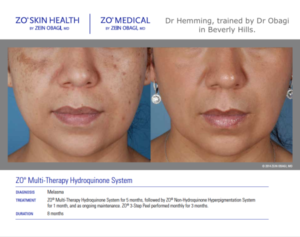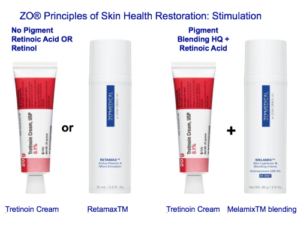Ok ladies & gents, let’s be honest. There was a time in all of our lives when we were convinced that “tan fat” looked better than “white fat”. And just a “nice tan” wouldn’t do…we had to be a shade away from burnt toast to be satisfied. Some of us took advantage of the unlimited tanning package & sealed it with a tingle factor lotion. And before tanning beds made their debut, some of us used baby oil with iodine, lathered up, and found a friends roof to literally fry our skin like chicken in Crisco! I confess, I did it all! I thought SPF was something that babies & old ladies used. Not me, I wanted to be baked well done! Because I avoided SPF like the plague, I am now having to pay for those bronzed beauty days.
Sun exposure and tanning beds play a huge part in hyperpigmentation, but they are not the only culprit. Hormonal issues are another reason you may be experiencing discoloration or other pigment issues. As your esthetician, I can identify the discoloration by its characteristics. By doing so, I can attempt to predict what caused the discoloration and how to effectively treat it. Before I explain, if you have any skin concerns, please do not rely on the information discussed in this blog to diagnose or treat yourself. I am always available for complementary consultations. To keep it simple, I am going to provide you with characteristics to differentiate between hyperpigmentation & melasma, how to treat it, and how to prevent it.
Hyperpigmentation is simply the darkening of the skin caused by increased melanin. This is harmless, but visually, a nuisance. It can be hereditary, but can also be caused from over exposure to the sun, over exposure to artificial sun light, trauma to the skin, acne, certain medications, and hormonal changes.
Melasma is bilateral patches of pigment that have lines of demarcation. Most people see the melasma on their cheeks, bridge of the nose, chin, forehead, and upper lip. It may appear on other parts of the body that are more exposed to the sun like the neck and arms. According to the American Academy of Dermatology, women are far more likely to get melasma. It is very common for women during pregnancy. For this reason, melasma has been dubbed the “pregnancy mask”. Melasma can be triggered by pregnancy, medications, hormonal imbalances, & birth control.
How can we treat & prevent hyperpigmentation & melasma? Hyperpigmentation can be treated using topical products. The most common topical treatment is hydroquinone. This is a depigmenting agent that actually blocks the process in the skin that leads to discoloration. Hydroquinone can be obtained by a prescription or it can be found properly dosed in products like the ZO Skin Health & Medical Products. Melamin C, Melamin, & Melamix contain 4% HQ and delivered properly twice a day for optimal results. When used correctly, the results are amazing!

Your practitioner should suggest a vitamin A derivative as a second topical medication to enhance the skin lightening process. Topicals such as retinols or retinoic acids like Retin-A, Tretinoin, Tazorac are frequently used in conjunction with hydroquinone for optimal results.

You can also start aesthetic treatments to maximize your results. These treatments include, chemical peels, microdermabrasion, & Intense Pulsed Light (IPL), just to name a few. During your skin care consultation, I can examine the depth of your pigment issues and suggest products and a treatment plan that is catered specifically to you.
Melasma is a little different. It can fade on its own. This usually happens post pregnancy or birth control pills. Some people, however, have melasma for many years. If the melasma doesn’t fade, it can be treated by topical treatments or aesthetic treatments.
Contrary to my old way of thinking, SPF is not just for babies & old ladies…its for everyone! Proper sun protection is the key to avoiding any future skin pigmenting issues. There are several options for an SPF & I’d be happy to recommend the one that is right for you. If you have an SPF, make sure you are using it correctly. We live in Louisiana & work under fluorescent lighting – we are ALWAYS exposed! Apply your SPF daily. You should check the label for reapply information and reapply as directed. Oclipse Smart Tone by ZO is great! ZO offers several SPF options, but Smart Tone is my favorite! It is a broad spectrum SPF 50 sunscreen the offers a sheer tinted primer that is designed to match any skin tone! Wear under makeup or alone for a beautiful finish!

I hope this blog has shed some light (no pun intended) on the hyperpigmentation/melasma issue. As always, I am here for you! Any questions or concerns, come see me at Timeless Rx. In the mean time, protect & take care of your skin!
Invest in your skin. It’s going to represent you for a very long time.
Your Esthetician,
Sam



